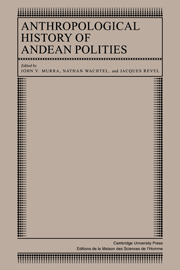Book contents
- Frontmatter
- Contents
- List of contributors
- Preface
- Introduction
- Part I Ecology and society
- Part II The ethnic group and the state
- Part III Systems of classification
- Part IV Symbolic representations and practices
- Part V From ethnic polities to communities
- 15 Men of the water: the Uru problem (sixteenth and seventeenth centuries)
- 16 The ethnic groups in the valleys of Larecaja: from descent to residence
- 17 The Andean community today
- Bibliography of published source
- Index
15 - Men of the water: the Uru problem (sixteenth and seventeenth centuries)
Published online by Cambridge University Press: 05 October 2010
- Frontmatter
- Contents
- List of contributors
- Preface
- Introduction
- Part I Ecology and society
- Part II The ethnic group and the state
- Part III Systems of classification
- Part IV Symbolic representations and practices
- Part V From ethnic polities to communities
- 15 Men of the water: the Uru problem (sixteenth and seventeenth centuries)
- 16 The ethnic groups in the valleys of Larecaja: from descent to residence
- 17 The Andean community today
- Bibliography of published source
- Index
Summary
Within the Andean area, and even in the whole of South America, the Uru are a true enigma, both historical and ethnographic (LaBarre 1941: 493). They have virtually vanished in our time, but in the sixteenth century they occupied a vast region, strung out along a watery axis that crossed the high plateau (the Azángaro River, Lake Titicaca, the Desaguadero River, Lake Poopó, the Lacajahuira River, and Lake Coipasa). Within this narrow belt they were about a quarter of the population. According to traditional stereotyping, which reaches us from the European eyewitnesses of the sixteenth century and was echoed by later travelers and even ethnologists, we deal here with Indians who were rough, barbarian, the kind most likely to be labeled “primitive” – different, it was alleged, from all other Andean populations. It was claimed that they could be recognized by their physical features (dolichocephaly, darker color), their language, clothing, and particularly their life-style. To use the evolutionary vocabulary, whereas their Aymara neighbors had reached a herding and farming stage, the Uru lingered behind, subsisting by fishing, hunting waterfowl, and gathering. Thus they were the object of a truly racist rejection, not only by other Indians but even by the best of our sources, who place them at the very edge of humanity. Thus, the Jesuit José de Acosta: “These Uru are so brutish that they do not consider themselves human.
- Type
- Chapter
- Information
- Anthropological History of Andean Polities , pp. 283 - 310Publisher: Cambridge University PressPrint publication year: 1986
- 11
- Cited by



